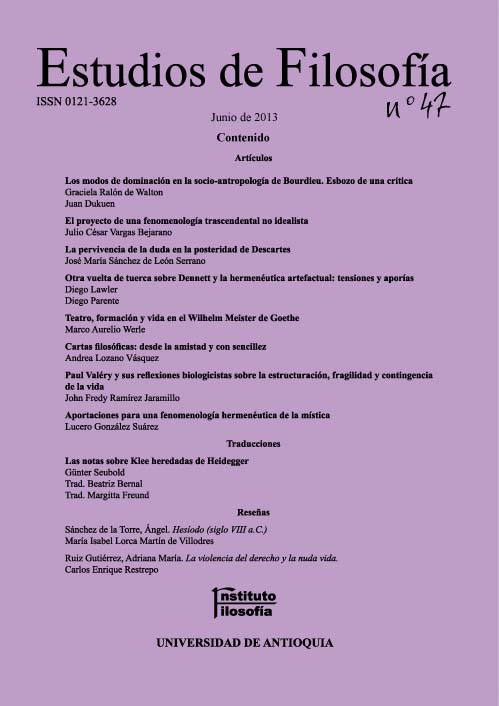Another turn of the screw on Dennett and artifactual hermeneutics: tensions and aporias
DOI:
https://doi.org/10.17533/udea.ef.16649Keywords:
Hermeneutics, Technical Artifacts, Dennett, Normativity, Technical function.Abstract
This work focuses on the application to technical artefact of the philosophical approach proposed by Daniel Dennett to elucidate the field of artificial things. In particular, it suggests two things. Firstly, that this application does not allow us to fully understand the normative dimension that covers the practical sphere of our production and use of technical artefact. Secondly, that this application promotes a very liberal approach on attribution of functions to technical artefact that makes unrecognisable the very idea of technical function. This paper is composed of three sections. The first one characterizes the artifactual hermeneutics promoted by Dennett’s approach. It analyses the stance of reverse engineering, the physical one and the design and intentional stance respectively. The second part discusses the analogy between texts and artefact and reconstructs the strategy embedded in this analogy. The last part presents a critical assessment of Dennett’s proposal regarding its application to the field of technical artefact.
Downloads
References
BIJKER, W. (1995) Of Bicycles, Bakelites, and Bulbs: Towards a Theory of Sociotechnical Change, Cambridge: MIT Press.
BIJKER, W. & PINCH, T. (1987) “The social construction of facts and artifacts: Or how the sociology of science and the sociology of technology might bene t each other”, en: W. Bijker, T. Hughes y T. Pinch (Eds.). The social construction of technological systems, Cambridge: MIT Press.
CHEMERO, A. (2009) Radical embodied cognitive science, Londres: MIT Press. DOI: https://doi.org/10.7551/mitpress/8367.001.0001
DENNETT, D. (1996) Kinds of Minds, Londres: Wiedenfeld & Nicholson.
DENNETT, D. (1995) Darwin ́s Dangereous Idea: Evolution and the Meanings of Life, Nueva York: Allen Lane and Penguin Books.
DENNETT, D. (1990) “The Interpretation of Texts, People and other Artifacts”, en: Philosophy and Phenomenology Research, 1, Supp. Fall 1990, pp. 177-193. DOI: https://doi.org/10.2307/2108038
DENNETT, D. (1987) The Intentional Stance, New York: Basil Blackwell.
DENNETT, D. (1978) Brainstorms: Philosophical Essays on Mind and Psychology, Hassocks: Harverster Press.
ECO, U. (1995) Interpretación y sobreinterpretación, Nueva York: Cambridge University Press.
GIBSON, J. J. (1986) The ecological approach to visual perception, New Jersey: Lawrence Elbaum Associates.
GRINT, K. & WOOLGAR, S. (1992) “Computers, Guns, and Roses: What’s Social about Being Shot?”, en: Science, Technology and Human Values, 17, No. 3, pp. 366-380. DOI: https://doi.org/10.1177/016224399201700306
MARR, D. (1985) Una investigación basada en el cálculo acerca de la representación y el procesamiento humano de la información visual, Madrid: Alianza.
MILLER, D. (1994) “Artefacts and the meaning of things”, en: Companion Encyclopedia of Anthropology, Tim Ingold (Ed.), Londres & Nueva York: Routledge.
RICOEUR, P. (2001) Del texto a la acción, Buenos Aires: F.C.E.
THOMASSON, A. (2003) “Realism and human kinds”, en: Philosophy and phenomenological research, vol. LXVII, 3, pp. 580-609. DOI: https://doi.org/10.1111/j.1933-1592.2003.tb00309.x
TOMASELLO, M. (1999) The cultural origins of human cognition, Cambridge: Harvard University Press. DOI: https://doi.org/10.4159/9780674044371
VAESEN, K. & VAN AMEONGEN, M. (2008) “Optimality vs. intent: Limitations of Dennett’s artefact hermeneutics”, en: Philosophical Psychology, 21, 779-797. DOI: https://doi.org/10.1080/09515080802516204
VERMAAS, P. et al. (2011) “The design stance and its artefacts”, en: Synthese, 2011, DOI: 10.1007/s11229-011-9885-9. DOI: https://doi.org/10.1007/s11229-011-9885-9
WIMSATT, W. & BEARDSLEY, M. (1954) “The Intentional Fallacy”, en: The Verbal Icon, Kentucky: University of Kentucky Press.
Downloads
Published
How to Cite
Issue
Section
Categories
License
Copyright (c) 2013 Diego Lawler, Diego Parente

This work is licensed under a Creative Commons Attribution-NonCommercial-ShareAlike 4.0 International License.
Authors who publish with this journal agree to the following terms:
1. The Author retains copyright in the Work, where the term "Work" shall include all digital objects that may result in subsequent electronic publication or distribution.
2. Upon acceptance of the Work, the author shall grant to the Publisher the right of first publication of the Work.
3. The Author shall grant to the Publisher a nonexclusive perpetual right and license to publish, archive, and make accessible the Work in whole or in part in all forms of media now or hereafter known under a Creative Commons Attribution-NoCommercia-ShareAlike (CC BY-NC-SA 4.0), or its equivalent, which, for the avoidance of doubt, allows others to copy, distribute, and transmit the Work under the following conditions: (a) Attribution: Other users must attribute the Work in the manner specified by the author as indicated on the journal Web site;(b) Noncommercial: Other users (including Publisher) may not use this Work for commercial purposes;
4. The Author is able to enter into separate, additional contractual arrangements for the nonexclusive distribution of the journal's published version of the Work (e.g., post it to an institutional repository or publish it in a book), as long as there is provided in the document an acknowledgement of its initial publication in this journal;
5. Authors are permitted, and Estudios de Filosofía promotes, to post online the preprint manuscript of the Work in institutional repositories or on their Websites prior to and during the submission process, as it can lead to productive exchanges, as well as earlier and greater citation of published work (see The Effect of Open Access). Any such posting made before acceptance and publication of the Work is expected be updated upon publication to include a reference to the Estudios de Filosofía's assigned URL to the Article and its final published version in Estudios de Filosofía.















